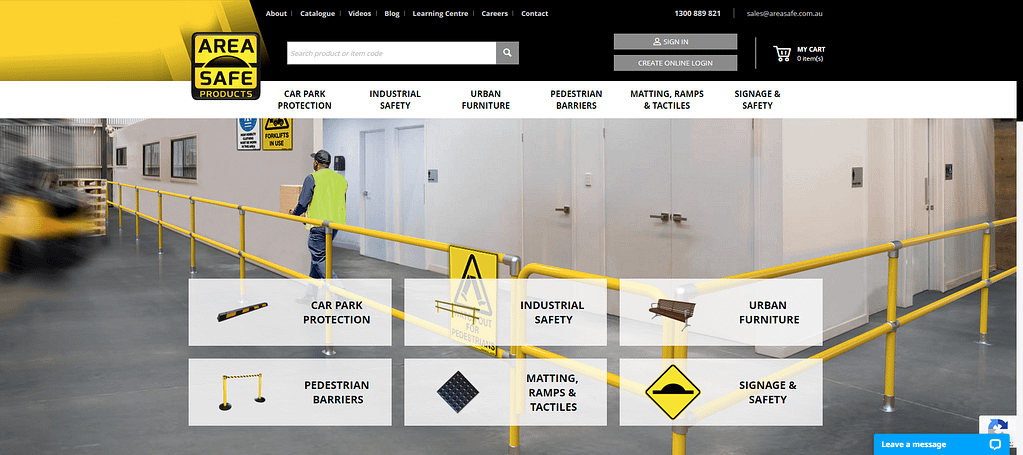After the recession in 2009, the industry of eCommerce building materials has recovered and continues to grow. According to Statista, the French Saint-Gobain and China National Building are two leading companies of the construction industry with the highest sales now.
The Similarweb source names the following websites as the top companies operating in the construction and building material business:
- qcc.com
- grainger.com
- cat.com
- inchcalculator.com
- Regione.veneto.it
- obi.hu
- supplyhouse.com
- buildertrend.net
Speaking about the sales channels, marketplaces show the highest rates of growth in the construction industry. This growth is attributed to the involvement of new market players – vendors of building materials. The better conditions you provide, the more sellers you gain. Vendors choose a place where to trade as:
- There is no need to run a website,
- They get convenient payment and shipping tools,
- They get help in marketing their product.
Marketplace can take all these worries upon itself.
However, 90% of beginners quit the business facing the first challenges. In this post, we analyze all the important questions before the start of sales – selling schemes and marketplace rules, mistakes of beginners and how to avoid them.
Selling workflows on a building material marketplace
There are two main sales schemes on marketplaces: FBS and FBO. The difference is in who is involved in fulfillment – product storage, packaging and delivery. This can be done by the seller (FBS) or delegated to the site (FBO).
At FBS, vendors need their own warehouse connected to the platform’s personal account. They upload products, specify the product stocks, pack orders after payment, print documents, bring the order and documents to the marketplace pick-up point or transfer them to the courier.
At FBO, vendors only need to ship items to the marketplace warehouse that collects and delivers orders. At the same time, they pay for storage even if there are no sales.
No matter which scheme is used to sell construction materials, the seller should meet the marketplace rules that you, as a marketplace owner, should think over in advance.
Marketplace rules of selling
When deciding on the marketplace rules of selling, consider the experience of similar platforms
1. Fee amount
Marketplace owners impose fees depending on the product category and extra services. For example, eBay, has the following fees for sellers:
- Insertion fees
- Final value fees
- Basic fees for most categories
- Fees for optional listings upgrade
- Dispute fees
- International fees
The cost of selling on Amazon depends on your vendor plan, product category, fulfillment, and other variables. Selling plan costs start from $0.99 per unit sold. Vendors should also pay a referral fee for each item sold. Depending on the product category, their amount varies between 8% and 15%. The cost of order shipping depends on the delivery method: FBS or FBO (they call it FBA – Fulfillment by Amazon).
The AliExpress fee amounts from 5 to 8%.
2. Payout frequency
Payment for orders does not go directly to the seller, but to the account of the marketplace. Then they are transferred to the seller minus the commission. Some sites do this once a week, some the next day.
3. Product delivery conditions for vendors
If you provide the opportunity to work according to the FBO scheme, consider the conditions: where and at what time the vendor needs to deliver the goods.
4. Requirements for sellers
Think through the requirements for partners: refuse to place an item due to an unregistered trademark or seller status.
6. Price formation
You can spur competition among vendors by introducing a feature that will show if a product is more expensive or cheaper from another seller.
7. Warehouse management
Integrate a warehouse management system to provide merchants with a warehouse management tool. Or leave keeping the track of inventory to the sellers. With automatic inventory management, your marketplace will gain more trust from buyers.
8. Product uploading and moderation
To start selling on some marketplaces, it is enough to provide a price list and a catalog, while others have moderation. It is important to set up automatic unloading of goods, which will not accept items if not all fields are filled out.
How to sell building materials on a marketplace
Selling building materials is not so straightford. So, the construction marketplace owner’s task is to facilitate this process for vendors: allow selling all kinds or niche-specific construction material, and the ability to have all selling tools in one place at a standardised rate. Below are some recommendations on how to organise the selling process on your marketplace.
Keep track of competitors
Follow the example Infra.Market. This building materials marketplace provides construction companies with a complete procurement solution. You can copy the way they present their store and services and follow all the footsteps in selling materials such as TMT bars, cement, or bricks.

Make your market of construction material an organised and a regulated place with clear pricing structure as both customers and vendors want to find the highest quality at a reasonable price.
Try to turn your multi-seller store into a platform that helps sellers quote a fair price and meet ethical business practices.
Choose your product and niche
Building materials OEMs produce products for construction with a wide variety of materials. They can be categorized as:
- natural materials like wood and timber
- man-made materials such as cement and glass.
You can concentrate your efforts on carving out a specific market for selling just one type of material, like cement or concrete, and invite reputable vendors for this market. If so, your store will be viewed as the appropriate platform for any business or contractor looking to buy these specific items.
A different choice is to broaden the product category and offer a variety of building supplies, such tiles, bricks, or paints.
You decide between creating a vertical and horizontal marketplace model. Clarity on this issue will affect other things, such as website design and marketing approach.
Create a functional design
The design should be concise, clear and uncluttered to help consumers find relevant products with ease and purchase faster, and the vendors to onboard easily and sell with comfort.
If we talk about a building materials marketplace with multiple storefronts, a big deal of vendor listings, don’t cram everything on one page. At least, leave space between blocks. By doing so, you make your information more easy to perceive for visitors without confusion.
If you want to drive more customers to your construction material marketplace, you need to design it in such a way that fits the wishes of your buyer. Take an example of our client – AreaSafe.com.au.

They introduced a functional design that serves the needs of actual customers. At this, it is not cluttered and easy to perceive. Creating a design can be cheaper with a ready-made theme or you can introduce your style with a custom appearance.
Invite vendors
After the marketplace design is done and functional, your next step is to invite vendors to list their items on your multi-vendor marketplace. You can provide them with a self-registration process or be a marketplace moderator approving each seller individually!
Facilitate vendor processes
In a multi-vendor model, sellers are as essential as consumers. Onboarding should be effortless and offer freedom to run their businesses.
You can provide vendors with individual dashboards, and vendor micro-stores with all the tools to track sales and promote products.
In Multi-Vendor it is possible to set different designs for micro-stores. Sellers can customize their pages on their own, placing their logos and choosing their color and styles. This is a cool option if you want each store to have a standalone design.
For better onboarding check if the chosen Multi-Vendor platform have the following:
- Admin panel and approval flow for vendor products
- Individual vendor dashboards and a tool to automatically upload inventories
- Automatic sales reports
- Organized marketplace order management
- Payment with the ability to split vendor payment and admin commission
With such useful features, you can guarantee complete transparency in your multi-vendor marketplace. They are perfect when it comes to ethical business practices – from onboarding to a sale.
Introduce mobile shopping
In 81 percent of cases, B2B clients want to take on procuring raw building material on their own. People building private property also wish to acquire goods themselves. What is the most suitable tool for this task? People mostly use cellphones to browse and choose appropriate materials for their homes and businesses. A mobile app can serve this need.
For CS-Cart Multi-Vendor, there is an easy way to introduce a mobile-first technology. With the responsive design making your website fit across any screen size, you give your business a forward thrust for organic searches. You can go further and use the power of Progressive Web Apps for a native-app experience to further improve your users’ browsing experience. It is possible with our PWAjet solution allowing customers to browse your site offline, add your marketplace to the mobile screen, and repeat the design and functionalities exactly as they are done on your marketplace.
3 main tips for a successful start of the building materials marketplace
- Implement a stock management system. This is especially important in the construction industry where there are many small parts. You can turn on automatic notifications for sellers about a new order, a change in its status, or when the product is out of stock.
- Help vendors promote. Implement a bonus program, launch promotions and send mailings with vendor offers.
- Keep analytics. For those who are just starting to work with marketplaces, one of the main mistakes is the lack of analytics. For example, customers often buy, but often return. Google Analytics Enhanced Ecommerce can see an expanded picture of what is happening on the marketplace and suggest ways to optimize sales.
Conclusion
To successfully sell on the marketplace, you need to monitor the product stocks, quickly process orders and use analytics. All this can be done in CS-Cart Multi-Vendor with minimal modifications to suit the conditions of your business. You can try the demo and we will show you how to adapt the standard site to your building materials marketplace.

